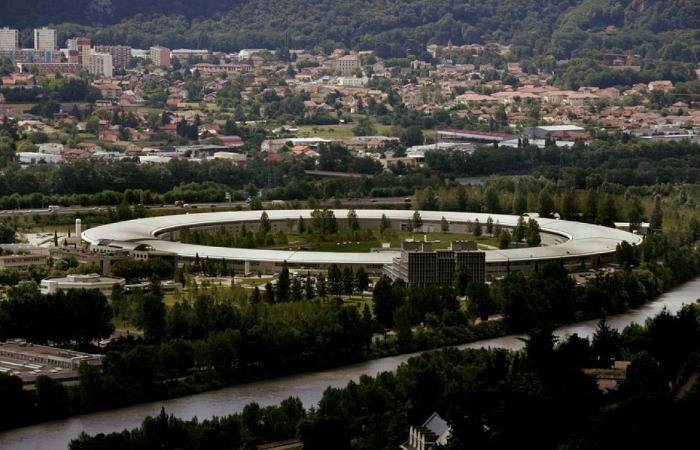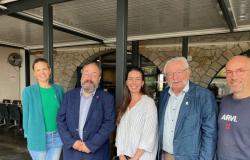
He is one of the prides of Grenoble. The Synchrotron, inaugurated on September 30, 1994 in a district of the capital of the Alps, is celebrating its 30th anniversary. The scientific ring, the most powerful in the world, has unraveled many mysteries and revolutionized research. Back to its history.
The essentials of the day: our exclusive selection
Every day, our editorial team reserves the best regional news for you. A selection just for you, to stay in touch with your regions.
France Télévisions uses your email address to send you the newsletter “The essentials of the day: our exclusive selection”. You can unsubscribe at any time via the link at the bottom of this newsletter. Our privacy policy
The history of the Synchrotron began in 1988. At the end of the 1980s, eleven countries agreed to create a scientific tool which would take the form of an immense ring of 844 meters in circumference. Inside: a source of light, the most efficient and intense in the world for analyzing the infinitely small. The Synchrotron was put into operation in 1994, after its inauguration on September 30 of the same year.
In 30 years, this tool has made it possible to make discoveries and unravel many mysteries. A look back at the history of this scientific ring, the most powerful in the world, located in Grenoble.
What exactly is the Synchrotron?
The Synchrotron is a kind of giant microscope, filled with electrons circulating in a ring. Launched at the speed of light, the particles produce X-rays, allowing us to explore the infinitely small.
“The objective is to characterize matter and living things. It is an accelerator of electrons which, when deflected by magnetic fields, emit synchrotron radiation which is used in around forty experiments around this large ring that we see from the Bastille,” explains Jean Daillant, general director of the Synchrotron.
Around the ring, there are more than forty laboratories where very high-level research is carried out by thousands of scientists from all over the world. Their target: the heart of matter.
“Scientists find something here that they can’t find anywhere else in the world, adds the Director General of the Synchrotron. We can experiment in key areas, but above all with tools that don’t exist elsewhere.”
Marine Cotte, scientist, on one of the beamlines of the ESRF, the European Synchrotron.
•
© ESRF/Stef Candé.
Unraveling the mystery of color, the Mona Lisa or even the Papyri: the great discoveries of the Synchrotron
In 30 years, the range of research has continued to expand: chemistry, materials physics, paleontology, archeology and cultural heritage, structural biology and health, environmental sciences, information sciences and nanotechnologies. ..
In total, nearly 10,000 scientists take turns day and night in this large laboratory to carry out this research.
The mystery of the Mona Lisa in 2010
Among the great discoveries of recent years, Grenoble scientists unraveled the mysteries of the Mona Lisa in 2010 and thus understood the technique of “shaded”used by Leonardo da Vinci, a technique which gives a blurred effect to the famous painter’s paintings.
To achieve this effect, scientists discovered that Leonardo da Vinci could apply up to 30 thin layers of varnish to his paintings. Layers measuring 1 to 2 microns, or half the thickness of a human hair, for a total thickness not exceeding 30 to 40 microns.
Leonardo da Vinci’s “sfumato”: up to 30 thin layers of varnish to give this “wispy” appearance to the Mona Lisa.
•
© V.Solé/ESRF.
How is color made?
In 2015, a study on color was carried out by British scientists. Their objective: to understand how nature reproduces unalterable colors and to understand why the feathers of birds or the wings of butterflies never fade over time, unlike human hair.
This study was carried out by scientists on the Jay, a bird with particular colors. They “entered” the nanostructure of the Jay’s feather, then into a hair, up to the spongy material composed of orifices. It is the size of these cavities and their distance that decides the black, blue and white color. Like a human hair with several shades.
How do dinosaurs breathe?
In 2021, an international scientific team was able to demonstrate how certain dinosaurs breathed. For this study, scientists looked at a skeleton of a young dinosaur herbivore recognizable by its large sharp canines, and 200 million years old.
For a long time, paleontologists assumed that all dinosaurs breathed like birds because they had similar respiratory anatomy. But this study then reveals that the dinosaur in question does not have the same respiratory system as birds – it has paddle-shaped ribs, small toothpick-shaped bones, and inflates both its chest and belly to breathe. A study possible only thanks to the synchrotron and which allows considerable progress in understanding the evolution of these reptiles.
What is papyrus made of?
In 2023, researchers are working to understand how papyrus is made and thus better preserve it. Thanks to the synchrotron’s ultra-powerful X-ray, they were able to decipher its mysteries, without damaging the samples. bThese papyri would be composed of three layers, probably with the work of several scribes.
A team of researchers from the Grenoble Synchrotron analyzes 2000-year-old papyri without damaging them – April 2023
•
© France TV / Franck Ceroni
Create a “Google Earth” of the human body
In 2022, a team of scientists wants to carry out unprecedented mapping of the human body to better understand how our body functions. Scientists first used the microtomography technique for the first time on a lung infected with Covid-19.
Thanks to synchrotron X-rays, the precision obtained is 500 times more detailed than medical radiology. After reconstituting the organ in three dimensions, the researchers extended the technique to the entire human body.
A team of researchers from the Grenoble synchrotron are trying to map the human body.
•
© Azedine Kebabti / France 3 Alpes
This exploration at the cellular level could provide a better understanding of how our body functions. Ultimately, this atlas would make it possible to improve the treatment of various pathologies such as cancer, Alzheimer’s disease and even Covid.
A new machine 100 times more powerful in 2020
In 2020, a fourth generation machine entered service with a beam of light a hundred times brighter than the previous one. This new generation of synchrotron “opened a new era for science”expanding the exploration of matter at the nanometer scale. This possibility opens up to many fields such as health, the environment, energy, new materials for industry, but also paleontology.
This new machine has made it possible to carry out research on Covid-19 and to observe the intimate structure of the virus in order to develop drugs and vaccines.
Thanks to this latest generation machine, the Synchrotron maintains its leading position worldwide with “study tools which are truly without equivalent today”, tells us the general director, Jean Daillant. The objective for the years to come:continue to develop our equipment so that it remains at the cutting edge”concludes the director.





